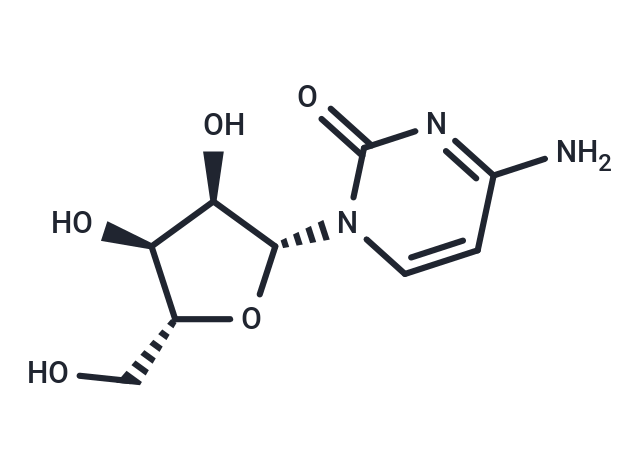Shopping Cart
Remove All Your shopping cart is currently empty
Your shopping cart is currently empty
Cytidine (Cytosine-1-β-D-ribofuranoside) is a pyrimidine nucleoside comprised of a cytosine bound to ribose via a beta-N1-glycosidic bond. Cytidine is a precursor for uridine. Both cytidine and uridine are utilized in RNA synthesis.

| Pack Size | Price | USA Warehouse | Global Warehouse | Quantity |
|---|---|---|---|---|
| 1 g | $31 | In Stock | In Stock | |
| 5 g | $64 | - | In Stock | |
| 10 g | $93 | - | In Stock | |
| 1 mL x 10 mM (in DMSO) | $29 | In Stock | In Stock |
| Description | Cytidine (Cytosine-1-β-D-ribofuranoside) is a pyrimidine nucleoside comprised of a cytosine bound to ribose via a beta-N1-glycosidic bond. Cytidine is a precursor for uridine. Both cytidine and uridine are utilized in RNA synthesis. |
| In vivo | D-cycloserine (DCS) facilitates extinction of conditioned freezing to the light CS when no drug pre-exposure has occurred, but pre-exposure to DCS just prior to conditioning disrupted the facilitation of extinction effect in mice. [1] D-cycloserine (DCS) which has a high affinity for the glycine modulatory site in the NMDA receptor complex modulated memory processing in a dose-dependent manner. DCS also facilitates retention in 'senescence-accelerated mice' in which impairment of learning andmemory increases with age. [2] D-cycloserine (DCS) exhibits facilitated extinction of fear but are able to reacquire fear of that conditioned stimulus (CS) in a similar manner as saline-treated control rats. DCS-treated rats exhibits generalized extinction (i.e., they are less fearful of a non-extinguished CS) in comparison to controls. [3] D-cycloserine (DCS), an antimycobacterial agent known to cross the blood-brain barrier, binds with high affinity to this glycine modulatory site, functions as a positive modulator, and facilitates performance of learningtasks in rats. DCS appears to be a potent cognitive enhancer at doses lower than those required for antibacterial activity. [4] D-cycloserine injections (3.25, 15, or 30 mg/kg) before 30 non-reinforced light exposures dose-dependently enhances extinction but does not influence fear-potentiated startle in rats that does not receive extinction training. [5] |
| Synonyms | Cytosine-1-β-D-ribofuranoside, Cytosine β-D-riboside |
| Molecular Weight | 243.22 |
| Formula | C9H13N3O5 |
| Cas No. | 65-46-3 |
| Smiles | O[C@H]1[C@@H](O[C@H](CO)[C@H]1O)N2C(=O)N=C(N)C=C2 |
| Relative Density. | 0.9867 - 0.99809 g/cm3 (55 - 25°C) |
| Color | White |
| Appearance | Solid |
| Storage | Powder: -20°C for 3 years | In solvent: -80°C for 1 year | Shipping with blue ice/Shipping at ambient temperature. | |||||||||||||||||||||||||||||||||||
| Solubility Information | H2O: 45 mg/mL (185.02 mM), Sonication is recommended. DMSO: 60 mg/mL (246.69 mM), Sonication is recommended. Ethanol: < 1 mg/mL (insoluble or slightly soluble) | |||||||||||||||||||||||||||||||||||
| In Vivo Formulation | 10% DMSO+40% PEG300+5% Tween 80+45% Saline: 2 mg/mL (8.22 mM), Sonication is recommended. Please add the solvents sequentially, clarifying the solution as much as possible before adding the next one. Dissolve by heating and/or sonication if necessary. Working solution is recommended to be prepared and used immediately. The formulation provided above is for reference purposes only. In vivo formulations may vary and should be modified based on specific experimental conditions. | |||||||||||||||||||||||||||||||||||
Solution Preparation Table | ||||||||||||||||||||||||||||||||||||
H2O/DMSO
| ||||||||||||||||||||||||||||||||||||
| Size | Quantity | Unit Price | Amount | Operation |
|---|

Copyright © 2015-2025 TargetMol Chemicals Inc. All Rights Reserved.